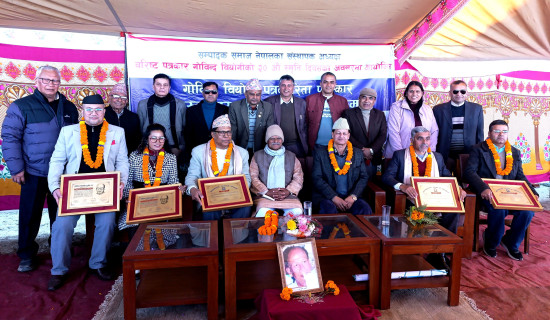- Saturday, 17 January 2026
Virtual Dispute Resolution Platforms
At a time when dispute resolution practitioners in the developed world have started to tap into the potentials of artificial intelligence (AI) in resolving cases, judiciary in Nepal has simply initiated the strategy to introduce ordinary forms of information and communication technology in making court adjudication quick and efficient for an enhanced justice dispensation. The process for fixing court hearing of the cases has been automated (swachalit) recently both in the Supreme Court and high courts as part of digitising justice service delivery management.
By integrating electronic automated processes into judicial system, several benefits like reduction in costs, efficiency in case management and transparency in court proceedings can be effectively secured. A study carried out on behalf of Forum for Women, Law and Development (FWLD) - a civil society organization - not very long back talks about the digitisation of justice initiatives in Nepal that include process reengineering, automation, data collection, e-filing, remote court process and technologies used to digitise, store, and provide access to legal documents and evidences. Moreover, the FWLD study also cautions that online dispute resolution may exacerbate digital divide by aggravating barriers to quality justice outcomes.
Virtual hearing
This is because access to such devices as telephone, television, personal computers must be ensured along with the adequacy and affordability of reliable internet and electricity for effective delivery of services. Needless to say, the COVID-19 pandemic has had a significant impact on the use of technology in the Nepali judiciary. The courts had been compelled to provide limited services during the pandemic that constrained and limited the scope of justice delivery. In order to ensure that justice dispensation process was not seriously constrained and impeded, judiciary developed the video conference directive 2078 and introduced reportedly the process to conduct virtual hearing.
Similarly, various forms of digitised services in judiciary have been initiated which include case management system, publication of daily and weekly cause lists on the website, sharing of details of case processes of the courts through websites and so on. Moreover, precedents, judgments of the court can be accessed online through websites. It thus appears that some initiatives have definitely been embarked in lending technology aided impetus to justice dispensation in the Nepali judiciary. But, corresponding technology aided initiatives seem to be lacking in the realm of alternative dispute resolution such as arbitration and mediation.
In mediation process, neutrals or mediators are referred to as the “third party”, but interestingly, internet technology used to aid in dispute resolution is referred to as the “fourth party”. The concept of the fourth party suggests that technology changes the communication pattern and power dynamics of the mediation process. It opens up new and imaginative ways for mediators and disputing parties to engage in communication process. Forms of technology that have relevance in online dispute resolution include e-mail, web forums, chat rooms, video conferencing, mobile and smart phone technology, voice over Internet protocol, social networking sites, web maps and so on.
On line dispute resolutions, in fact, challenges the conventional claims of mediation that face-to-face problem-solving is the most effective way to dealing with conflict, to uncover diverse interests and address relational aspects of the conflict. Empirical data doubt on the belief that parties need to sit physically in the same room for interest-based negotiation, deep listening and relational transformation to occur. In fact, some studies suggest that parties may be less positional when they are negotiating via e-mail or online chatting compared to face-to-face setting. Moreover, dispute resolution technology is no longer seen as a tool suitable only for settling e-commerce-generated disputes. It is increasingly used to supplement or replace face-to-face mediation processes especially through the use of tools such as tablets and smart phones.
In cross-border jurisdictions, on line dispute resolution is considered to be affordable and convenient because it minimises, and in some cases eliminates the need for participants to travel and reduces the costs associated with using physical meeting rooms. In terms of practice, on line dispute resolution proceedings may be ad hoc, as in the case of parties settling their dispute through an exchange of e-mails and Skype calls with the assistance of a mediator. Alternatively, they may be institutionalised, as in the case of parties submitting to a set of institutional mediation rules and participating in remote sessions hosted by an institutional platform on the dispute resolution provider’s server.
The relative affordability of online dispute resolution compared to traditional forms of cross-border dispute resolution presents a valuable opportunity to expand access to commercial justice for small enterprises in cross-border disputes. However, a challenge exists for the international development of online dispute resolution. It is due to the lack of a coherent infrastructure within which service providers can operate. Given that many on line dispute resolution service providers operate independently as they are not connected with a legal or professional association, there is fragmentation in standards and best practices of mediation service delivery.
Online dispute
Needless to say, United Nations agency called UNCITRAL has recognised the use of online dispute resolution in international mediation practices. In Art 2(2) of the Singapore Mediation Convention, the provision supporting online dispute resolution is clearly spelt out. This provision establishes that the writing requirement for a mediated settlement agreement may be met by electronic communication provided the information is accessible for subsequent reference.
What this means is that where a party seeks to enforce an international mediation agreement resulting from an online dispute resolution procedure in a state party to the Singapore Mediation Convention, the settlement agreement being electronic in nature, is unlikely to present an issue to its enforcement. Since alternative dispute resolution, especially mediation, has become increasingly popular in Nepal, the mediation act should be revised to uphold and recognise virtual platforms for dispute resolution. Furthermore, digital infrastructures need to be strengthened for reliable online dispute resolution services.
(The author is presently associated with Policy Research Institute (PRI) as a senior research fellow. rijalmukti@gmail.com)
















